Sargas, also designated as Theta Scorpii, is a binary star located in the zodiacal constellation of Scorpius. It is one of the brightest stars in the night sky.
Key Facts & Summary
- Theta Scorpii is located at around 300 light-years away from the Sun.
- Theta Scorpii is an evolved bright yellow giant star of spectral type F0 II.
- The star has an apparent magnitude of 1.87 and it has a companion of magnitude 5.36.
- Theta Scorpii’s absolute magnitude is estimated to be at -2.71.
- The radial velocity of the Theta Scorpii binary system is +1.4 km / +0.8 mi per second.
- Theta Scorpii is more massive than our Sun. It is estimated to have around 5.66 solar masses, with an estimative error of 0.65.
- One of the greatest feats of Theta Scorpii is its luminosity since it is around 1,834 times brighter than our Sun.
- Theta Scorpii has around 26 solar radii, thus it should be around 50 times bigger than our Sun.
- The surface gravity on Theta Scorpii has been measured to be at around 2.4 cgs.
- Theta Scorpii is a fast spinner, having a rotational velocity of around 125 km / 77.6 mi per second.
- The average surface temperatures on Theta Scorpii have been estimated at around 7,268 K.
- The companion of the primary star is situated at an angular separation of 6,470 arcseconds.
- Due to its rotational speed, Theta Scorpii has gained an oblate shape, thus its equatorial radius is around 19% larger than its polar radius.
- Theta Scorpii / Sargas – is the 39th brightest star in the night sky, it can be observed with the naked eye.
- Theta Scorpii has a fairly long rotation, given its size, completing one rotation in 10 days or so.
- The ultimate fate of Theta Scorpii is to become a massive white dwarf.
Theta Scorpii, also known as Sargas, is the third brightest star in the constellation of Scorpius. The name Sargas is of Sumerian origin and its meaning was lost to time.
Another variant of the name, Girtab, is also of Sumerian origin, and it simply means “scorpion”. Theta Scorpii is the most southerly bright star in Scorpio, closely anchoring the southern curve of the scorpion’s tail.
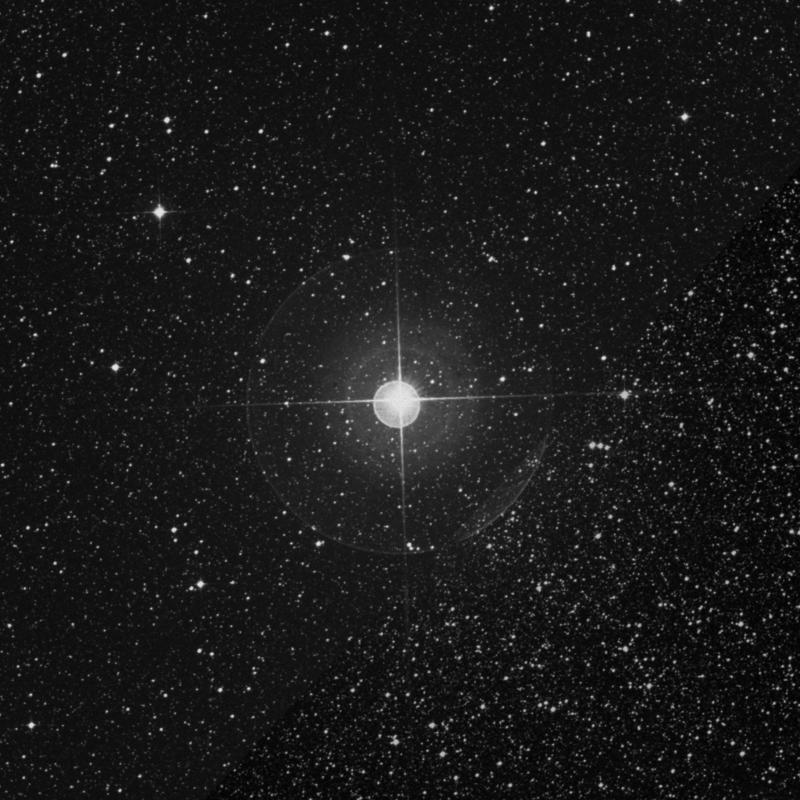
Theta Scorpii is the system’s Bayer designation, with its two components being designated as Theta Scorpii A and B, while the name Sargas officially only applies to the primary star.
Formation
Sargas’s exact age is currently unknown. However, we do know that the star is an evolved bright giant. Sargas formed from an interstellar medium of dust and gas.
Gravity pulled the swirling gas and dust together and resulted in the third brightest star of Scorpio, that we today now see.
Distance, Size, and Mass
Sargas is situated at around 300 light-years / 90 parsecs away from Earth. It is among the brightest stars in the night sky, easily visible with the naked eye.
Sargas’s mass is around 5.66, which means it is 566% more massive than our Sun. When it comes to its radius, things get even more impressive.
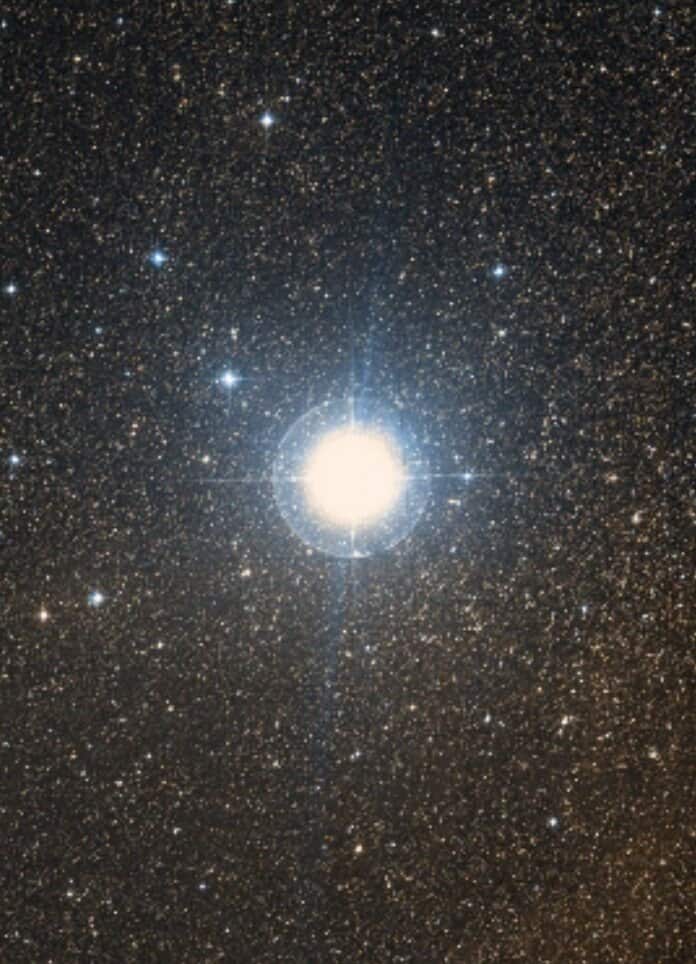
Due to its expansion phase, Sargas has reached a radius of 26 solar radii or 2.600% of the Sun’s radius. This means that Sargas is most likely at least 50 times bigger than our Sun.
When it comes to its companion, Theta Scorpii B, there is too little information about it currently available.
Other Characteristics
Sargas is an evolved bright giant of spectral type F0 II. Because of its current state, it’s radius has expanded several times. Also, its temperature, at 7,268 K , makes it 1.2 times hotter than our Sun.
Sargas is a very bright star, being 1,834 times brighter than our Sun. This gives it a yellow-white hue, typical of an F-type star. Sargas is also a fast spinner, having a rotational velocity of 125 km / 77.6 mi per second.
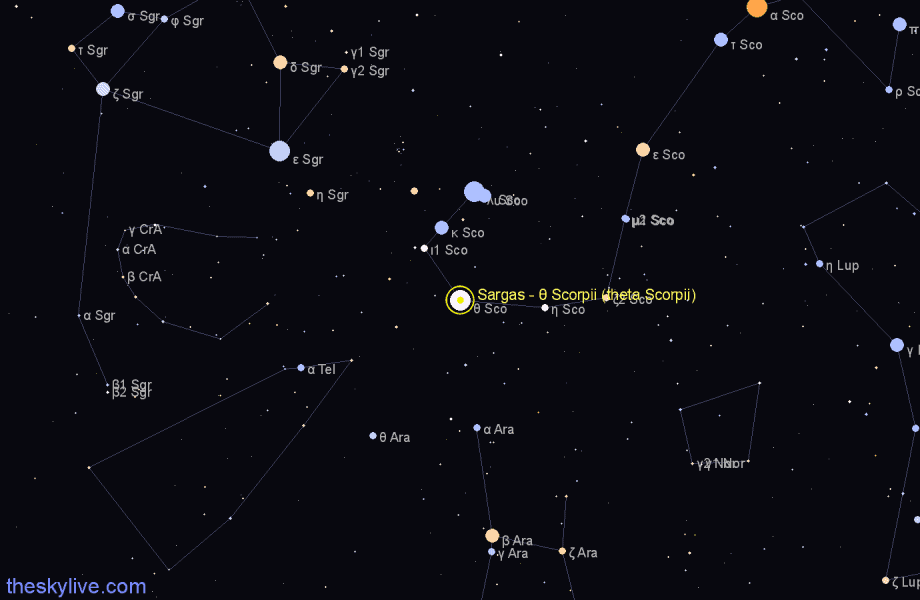
Because of this great speed, the star has gained an oblate shape making its equatorial radius around 19% larger than its polar radius. The star has an apparent magnitude of 1.87 and it has a companion of magnitude 5.36.
Some sources state that Sargas is a variable star, while others believe that it will become a variable star of the Cepheid type, in around a million years. Sargas has fairly long rotation, given its size, completing one rotation in 10 days or so.
Stellar System
Not much is currently known about the Theta Scorpii star system. The two components, Theta Scorpii A (Sargas), and Theta Scorpii B, are situated at an angular separation of 6,470 arcseconds.
Location
Sargas / Theta Scorpii is situated in the zodiacal constellation of Scorpius. It is the third brightest star in the constellation. This constellation is situated in the Southern celestial hemisphere.
The constellation of Scorpius is among the 48 constellations depicted by the Greek astronomer Ptolemy, in his 2nd century Almagest. It is an ancient constellation that pre-dated the Greeks, and it lies between Libra to the west and Sagittarius to the east.
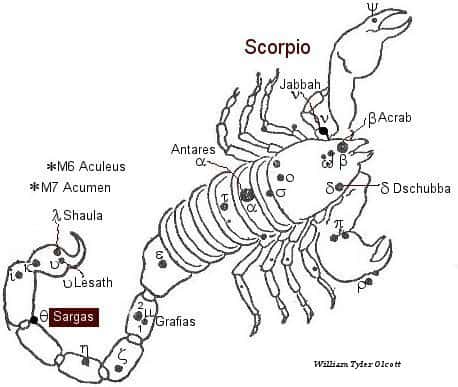
Scorpius is the 33rd constellation in size, occupying an area of 497 square degrees. It lies in the third quadrant of the southern hemisphere and can be seen at latitudes between +40 and -90 degrees.
Sargas is the most southerly bright star in the constellation, closely anchoring the southern curve of the celestial scorpion’s tail. Scorpius is filled with bright blue-white stars of class B.
This constellation is easy to find since it is located near the center of the Milky Way. It contains several notable stars and deep sky objects such as Antares, Shaula, the Butterfly Cluster, the Ptolemy Cluster, Cat’s Paw Nebula, the War and Peace nebula, and more.
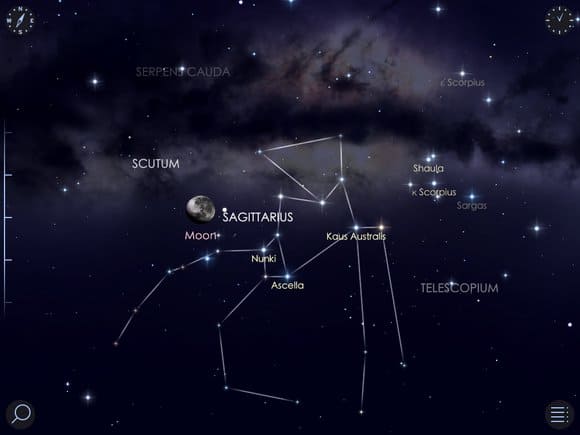
The Future
Sargas stands out in its constellation filled with bright blue-white stars of class B. The star is rapidly evolving with a dead helium core towards lower temperatures.
Around one hundred million years ago, Sargas was also a B star like its current numerous neighbors. As the star swells and its surface cools, it should, in under a million years become a Cepheid variable type of star.
It will then become a red giant five times brighter than it is now, at which point the helium in its core will begin to fuse carbon and oxygen, setting the stage for it to become a massive white dwarf.
Did you know?
- Sargas appears on the flag of Brazil, symbolizing the state of Alagoas.
- Sargas is moving farther away from the Sun at a speed of 1 kilometer per second.
- Sargas is situated in the south of the celestial equator, thus it is more visible from the southern hemisphere.
- Some believe that Sargas will become a Cepheid variable very similar to Mekbuda.
- The Chinese know Sargas as Wei Xiu wu – the Fifth Star of Tail – Tail referring to an asterism consisting of Theta Scorpii, Epsilon Scorpii, Zeta Scorpii, Eta Scorpii, Iota Scorpii, Kappa Scorpii, Lambda Scorpii, Mu Scorpii, and Upsilon Scorpii.
Sources:
Image sources:
- https://theskylive.com/sky/stars/star-images/65/6553_800.jpg
- https://pbs.twimg.com/media/DLAMx3cXoAALfGM.jpg
- https://theskylive.com/sky/stars/finder-charts/sargas-theta-scorpii-finder-chart.png?c=1586706592
- https://www.constellationsofwords.com/images/stars/Sargas.JPG
- https://images.techhive.com/images/article/2014/09/star-walk-2-ipad-100412204-large.jpg
